Overview
The American Trends Panel (ATP), created by Pew Research Center, is a nationally representative panel of randomly selected U.S. adults. Panelists participate via self-administered web surveys. Panelists who do not have internet access at home are provided with a tablet and wireless internet connection. Interviews are conducted in both English and Spanish. The panel is being managed by Ipsos.
Data in this report is drawn from ATP Wave 137, conducted from Oct. 24 to Nov. 5, 2023 among a sample of U.S. adults who are either a parent of at least one 18- to 34-year-old or who are themselves age 18 to 34 and have at least one living parent. A total of 4,512 panelists responded out of 5,118 who were sampled, for a response rate of 95% (AAPOR RR3). The cumulative response rate accounting for nonresponse to the recruitment surveys and attrition is 3%. The break-off rate among panelists who logged on to the survey and completed at least one item is less than 1%. The margin of sampling error for the sample of 3,017 respondents who are a parent of at least one 18- to 34-year-old is plus or minus 2.5 percentage points. The margin of sampling error for the sample of 1,495 respondents ages 18 to 34 who have at least one living parent is plus or minus 4.3 percentage points.5
Panel recruitment
The ATP was created in 2014, with the first cohort of panelists invited to join the panel at the end of a large, national, landline and cellphone random-digit-dial survey that was conducted in both English and Spanish. Two additional recruitments were conducted using the same method in 2015 and 2017, respectively. Across these three surveys, a total of 19,718 adults were invited to join the ATP, of whom 9,942 (50%) agreed to participate.
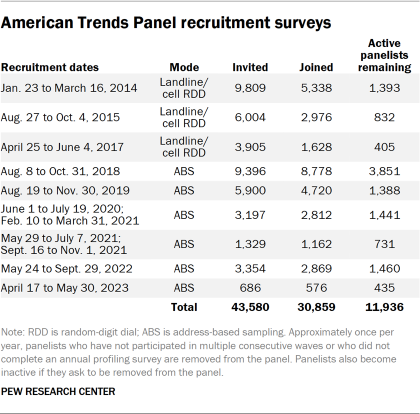
In August 2018, the ATP switched from telephone to address-based sampling (ABS) recruitment. A study cover letter and a pre-incentive are mailed to a stratified, random sample of households selected from the U.S. Postal Service’s Delivery Sequence File. This Postal Service file has been estimated to cover as much as 98% of the population, although some studies suggest that the coverage could be in the low 90% range.6 Within each sampled household, the adult with the next birthday is asked to participate. Other details of the ABS recruitment protocol have changed over time but are available upon request.7
We have recruited a national sample of U.S. adults to the ATP approximately once per year since 2014. In some years, the recruitment has included additional efforts (known as an “oversample”) to boost sample size with underrepresented groups. For example, Hispanic adults, Black adults and Asian adults were oversampled in 2019, 2022 and 2023, respectively.
Across the six address-based recruitments, a total of 23,862 adults were invited to join the ATP, of whom 20,917 agreed to join the panel and completed an initial profile survey. Of the 30,859 individuals who have ever joined the ATP, 11,936 remained active panelists and continued to receive survey invitations at the time this survey was conducted.
The American Trends Panel never uses breakout routers or chains that direct respondents to additional surveys.
Sample design
This survey was designed to cover two distinct subpopulations within the universe of noninstitutionalized persons ages 18 and older living in the U.S., including Alaska and Hawaii: 1) parents of at least one adult child ages 18 to 34 with whom they are in contact (excluding children who are currently enrolled in high school); and 2) adults ages 18 to 34 who have at least one living parent with whom they are in contact (excluding panelists who are currently enrolled in high school). All active panel members who reported belonging to either of these groups in ATP W133 (fielded in August 2023) were invited to participate in this wave. Prior to fielding, all eligible panelists were divided into separate groups depending on whether they were the parent of an 18- to 34-year-old or were 18 to 34 years old and had a living parent. Panelists who were eligible for inclusion in both groups were randomly assigned to one or the other with equal probability and their sampling weights were adjusted accordingly. At the beginning of the survey, respondents were asked to enumerate either their 18-to 34-year-old children or their living parents depending on their sample group. Respondents who did not enumerate any eligible children or parents were screened out as ineligible.
Questionnaire development and testing
The questionnaire was developed by Pew Research Center in consultation with Ipsos. The web program was rigorously tested on both PC and mobile devices by the Ipsos project management team and Pew Research Center researchers. The Ipsos project management team also populated test data that was analyzed in SPSS to ensure the logic and randomizations were working as intended before launching the survey.
Random selection
For some questions, panelists with more than one enumerated adult child ages 18 to 34 (in the survey of parents) or more than one living parent (in the survey of young adults) were asked to think about a specific child/parent. This child/parent was randomly selected from the enumerated list at the beginning of each survey.
Incentives
All respondents were offered a post-paid incentive for their participation. Respondents could choose to receive the post-paid incentive in the form of a check or a gift code to Amazon.com or could choose to decline the incentive. Incentive amounts ranged from $5 to $15 depending on whether the respondent belongs to a part of the population that is harder or easier to reach. Differential incentive amounts were designed to increase panel survey participation among groups that traditionally have low survey response propensities.
Data collection protocol
The data collection field period for this survey was Oct. 24 to Nov. 5, 2023. Postcard notifications were mailed to all ATP panelists with a known residential address on Oct. 24.
Invitations were sent out in separate launches: soft launch and full launch. Sixty panelists were included in the first soft launch, which began with an initial invitation sent on Oct. 24. A precautionary second soft launch was carried out to confirm that a correction made on the backend of the survey program after the first soft launch. The second soft launch did not affect the survey in any way. One hundred panelists were included in the second soft launch, which began with an initial invitation sent on Oct. 26. The second soft launch confirmed that the program was working as it should and that the correction had no impact on data or survey results. The ATP panelists chosen for both soft launches were known responders who had completed previous ATP surveys within one day of receiving their invitation. All remaining English- and Spanish-speaking sampled panelists were included in the full launch and were sent an invitation on Oct. 27.
All panelists with an email address received an email invitation and up to three email reminders if they did not respond to the survey. All ATP panelists who consented to SMS messages received an SMS invitation and up to three SMS reminders.
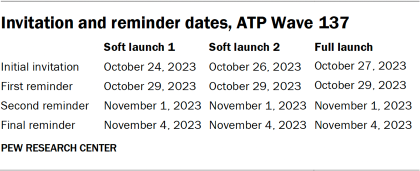
Data quality checks
To ensure high-quality data, the Center’s researchers performed data quality checks to identify any respondents showing clear patterns of satisficing. This includes checking for whether respondents left questions blank at very high rates or always selected the first or last answer presented. As a result of this checking, three ATP respondents were removed from the survey dataset prior to weighting and analysis. Thirteen other ATP respondents were removed from the survey dataset after providing feedback that they were not actually eligible for the survey.
Weighting
This survey was weighted in a multistep process that accounts for multiple stages of sampling and nonresponse that occur at different points in the survey process. First, each panelist begins with a base weight that reflects their probability of selection for their initial recruitment survey. These weights are then rescaled and adjusted to account for changes in the design of ATP recruitment surveys from year to year.
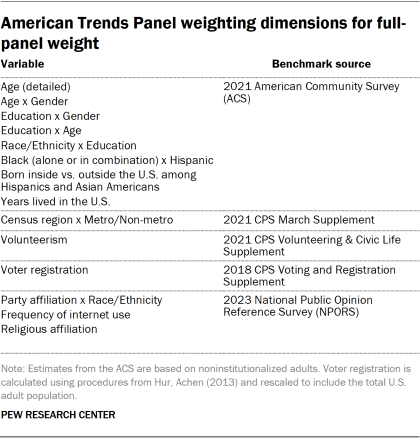
To correct for nonresponse and panel attrition, the base weights for all panelists who responded to the 2023 Annual Profile Survey (ATP Wave 133) were calibrated to align with the population benchmarks in the accompanying table to create a full-panel weight.
Among respondents to this wave, the full-panel weight was then used as the basis for separate sets of weights for each of the two sample groups. In each sample group, the weights for respondents who were eligible for inclusion in both groups were multiplied by two to account for the probability that they were assigned to that group.
Next, the weights for respondents in each group were calibrated to align with a set of weighting parameters calculated on the full set of eligible respondents from Wave 133 using the full-panel weight. For both sample groups, these included gender, education, race/ethnicity, years lived in the U.S., census region, metropolitan status, frequency of internet use, religion, party affiliation, voter registration and volunteerism. For the sample group of parents with children ages 18 to 34, the weighting included an additional parameter for age. Finally, both sets of weights were trimmed at the 1st and 99th percentiles to reduce the loss in precision stemming from variance in the weights. Sampling errors and tests of statistical significance take into account the effect of weighting.
The following table shows the unweighted sample sizes and the error attributable to sampling that would be expected at the 95% level of confidence for different groups in the survey.
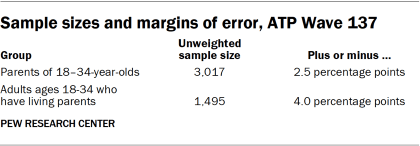
Sample sizes and sampling errors for other subgroups are available upon request. In addition to sampling error, one should bear in mind that question wording and practical difficulties in conducting surveys can introduce error or bias into the findings of opinion polls.
Dispositions and response rates
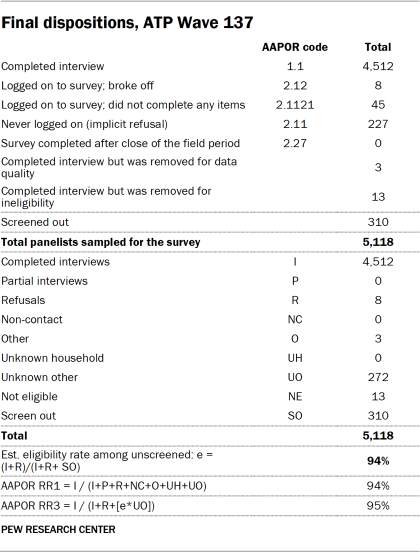
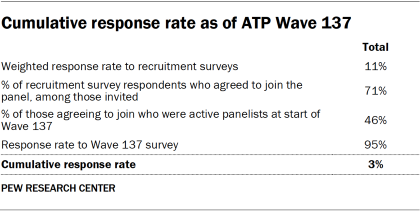
How family income tiers are calculated
Family income data reported in this study is adjusted for household size and cost-of-living differences by geography. Panelists then are assigned to income tiers that are based on the median adjusted family income of all American Trends Panel members. The process uses the following steps:
- First, panelists are assigned to the midpoint of the income range they selected in a family income question that was measured on either the most recent annual profile survey or, for newly recruited panelists, their recruitment survey. This provides an approximate income value that can be used in calculations for the adjustment.
- Next, these income values are adjusted for the cost of living in the geographic area where the panelist lives. This is calculated using price indexes published by the U.S. Bureau of Economic Analysis. These indexes, known as Regional Price Parities (RPP), compare the prices of goods and services across all U.S. metropolitan statistical areas as well as non-metro areas with the national average prices for the same goods and services. The most recent available data at the time of the annual profile survey is from 2021. Those who fall outside of metropolitan statistical areas are assigned the overall RPP for their state’s non-metropolitan area.
- Family incomes are further adjusted for the number of people in a household using the methodology from Pew Research Center’s previous work on the American middle class. This is done because a four-person household with an income of say, $50,000, faces a tighter budget constraint than a two-person household with the same income.
- Panelists are then assigned an income tier. “Middle-income” adults are in families with adjusted family incomes that are between two-thirds and double the median adjusted family income for the full ATP at the time of the most recent annual profile survey. The median adjusted family income for the panel is roughly $71,800. Using this median income, the middle-income range is about $47,900 to $143,600. Lower-income families have adjusted incomes less than $47,900 and upper-income families have adjusted incomes greater than $143,600 (all figures expressed in 2022 dollars and scaled to a household size of three). If a panelist did not provide their income and/or their household size, they are assigned “no answer” in the income tier variable.
Two examples of how a given area’s cost-of-living adjustment was calculated are as follows: the Anniston-Oxford metropolitan area in Alabama is a relatively inexpensive area, with a price level that is 16.2% less than the national average. The San Francisco-Oakland-Berkeley metropolitan area in California is one of the most expensive areas, with a price level that is 19.8% higher than the national average. Income in the sample is adjusted to make up for this difference. As a result, a family with an income of $41,900 in the Anniston-Oxford area is as well off financially as a family of the same size with an income of $59,900 in San Francisco.
Secondary data
Current Population Survey
Part of the analysis contrasting young adults today and 30 years ago is derived from the Annual Social and Economic Supplement (ASEC), which is conducted in March of every year as part of the Current Population Survey (CPS). Administered jointly by the U.S. Census Bureau and the Bureau of Labor Statistics, the CPS is a monthly survey of approximately 60,000 occupied households that typically interviews about 50,000 households. It is the source of the nation’s official statistics on unemployment and is explicitly designed to survey the labor force. It is representative of the civilian noninstitutionalized population. The ASEC survey in March typically features an expanded sample of more than 75,000 households with about 70,000 interviews. The ASEC collected in 2023 had about 57,000 households.
The CPS microdata used in this report is the Integrated Public Use Microdata Series (IPUMS), provided by the University of Minnesota. The IPUMS assigns uniform codes, to the extent possible, to data collected in the CPS over the years. Read more about the IPUMS-CPS, including variable definition and sampling error.
Survey of Consumer Finances
The Survey of Consumer Finances (SCF) is a triennial cross-sectional survey of U.S. families and 2022 is the most recent survey year available.
The survey data include information on families’ balance sheets, pensions, income, and demographic characteristics. Information is also included from related surveys of pension providers and the earlier such surveys conducted by the Federal Reserve Board. To ensure the representativeness of the study, respondents are selected randomly. A strong attempt is made to select families from all economic strata. Outstanding mortgages and student loans are adjusted for inflation.
The study is sponsored by the Federal Reserve Board in cooperation with the Department of the Treasury.




